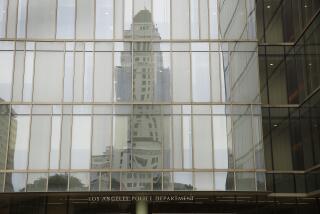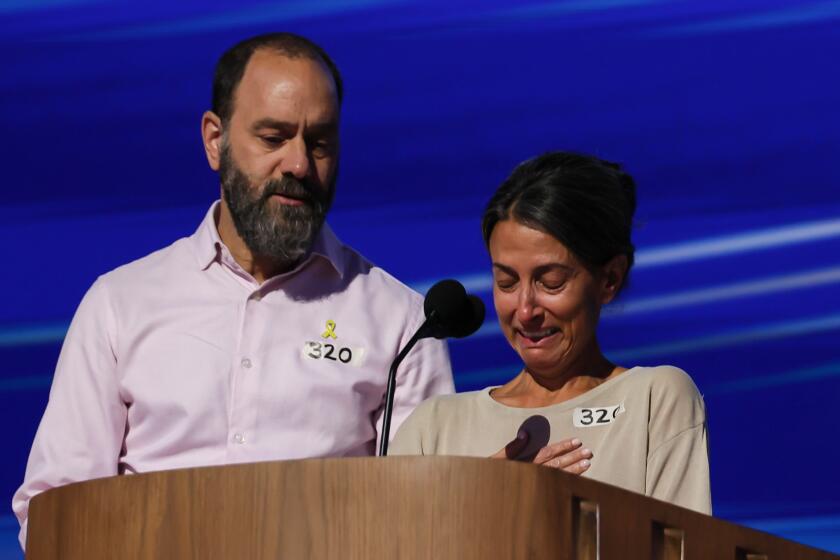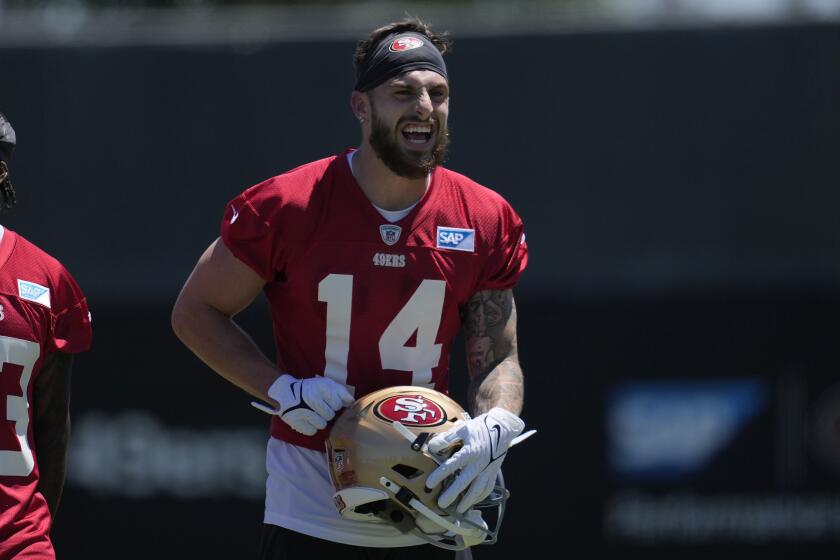LAPD Chemist Testifies on Blood Test Results : Simpson case: He says defendant is among 0.5% of people whose blood matches one drop. Ex-juror ailing.
Testifying for the first time about test results that prosecutors say link O.J. Simpson to a pair of brutal murders, a police chemist said Tuesday that a blood drop near the scene of the crime contains some characteristics identical to Simpson’s while stains discovered in his bedroom could have come from his murdered ex-wife.
Referring to a chart that portrayed the results of Los Angeles Police Department blood testing, assistant LAPD laboratory director Gregory Matheson for the first time presented test results that prosecutors say point to Simpson as the person who killed Ronald Lyle Goldman and Nicole Brown Simpson. Simpson has pleaded not guilty to those killings, but prosecutors have long said they will prove he was the culprit largely through blood, hair, fibers and other physical evidence.
The results presented Tuesday came in the form of testimony and a prosecution chart and indicate that only 0.5% of the population could have left one of the blood drops leading away from the two victims. According to the chart, Simpson was among those who could have been the source of that drop, one that Matheson had testified about during last summer’s preliminary hearing.
In addition, Matheson testified that Nicole Simpson could have been the source of blood found on a sock in her ex-husband’s bedroom, blood that Matheson said could not have come from O.J. Simpson. Those socks long have been among the case’s most hotly contested pieces of evidence: DNA tests also have pointed to Nicole Simpson as the probable source of blood on the socks, but defense attorneys have suggested that the blood on them may have been planted by police determined to frame Simpson for the murders.
Although the results presented Tuesday are taken from conventional testing, not the more precise DNA analysis later performed on some of the same samples, they form the first pillar of the prosecution’s physical-evidence case, suggesting the trail of blood that prosecutors say connects Simpson to the double homicide.
Matheson’s testimony was dry and sometimes technical, but his findings mark the first time that jurors have heard of results that purport to connect Simpson to the crime scene or that allegedly link the victims to Simpson’s home.
As Matheson testified, Deputy Dist. Atty. Hank Goldberg sought to achieve two ends: explaining the array of test results and simultaneously debunking defense allegations that sloppy handling, lab contamination or deliberate attempts to frame Simpson rendered the tests unreliable.
That dual challenge was magnified by the technical jargon associated with the tests--vocabulary so dense that Goldberg joked at one point about his struggles to pronounce the name of one of the tests. When he overshot the lunch break by a few minutes, Goldberg apologized by wryly commenting that he was so swept up in one of his charts that he lost track of the time. A few members of the audience laughed appreciatively.
Despite the technical nature of the topic, legal experts said the latest turn in the prosecution’s case marked the beginning of the most important part of the trial--the phase in which government lawyers attempt to link Simpson directly to the murders.
“Finally, they are presenting evidence which ties O.J. Simpson to the crimes,” said Craig Silverman, chief deputy district attorney in Denver. “Yes, it’s circumstantial evidence, but remember the vast majority of people in the world don’t match the characteristics--blood type . . . and the enzyme breakdowns--of O.J. Simpson’s blood.”
Others warned, however, that the presentation of that technical evidence was so flat that its significance may be partly lost on the jury.
“They finally put the witness who is a linchpin in that part of the case on the stand,” said Howard Price, a Beverly Hills defense lawyer, “and it takes a day and a half to get to what he has to say. Then they put it in the most boring, disjointed and incomprehensible way imaginable.”
Although Goldberg’s questioning bogged down at points, he managed to complete it near the end of Tuesday’s session, allowing Simpson attorney Robert Blasier to begin his cross-examination. Blasier opened his questioning with a pattern that has become familiar: He suggested that the prosecution witness’s training and education were inferior to those of defense experts, and he tried to elicit testimony that would undermine the credibility of other prosecution witnesses as well.
Specifically, the lawyer asked Matheson whether two criminalists, Dennis Fung and Andrea Mazzola, were certified by various professional organizations or whether they attended seminars in which Matheson participated. Matheson said he did not know.
Near the end of the day, Blasier also questioned Matheson about his boss, eliciting his testimony that lab director Michele Kestler is married to an LAPD detective and asking whether she socializes with police officers. Superior Court Judge Lance A. Ito, who is married to the highest-ranking woman in the LAPD, sustained an objection to that question.
Technical Testimony
Nowhere was Tuesday’s presentation more dense than in a long portion of the examination devoted to trying to explain away a brief but provocative comment that lead Simpson trial lawyer Johnnie L. Cochran Jr. made during his opening statement.
In his initial remarks to the jury, Cochran excerpted a portion of a police report and told the panel that blood found underneath the fingernails of Nicole Simpson did not match O.J. Simpson’s or that of either victim. Cochran’s contention: that police had failed to explore the possibility of another suspect in their haste and determination to pin the blame on Simpson.
Prosecutors objected furiously to that insinuation, and Goldberg took great pains Tuesday to have Matheson explain the test results of those fingernail scrapings. Using a special form of blood typing, blood from beneath Nicole Simpson’s nails initially had been listed as possibly being type B--a type that could not have come from either Simpson or the victims.
Matheson explained, however, that as blood degrades, the results of that particular form of testing can be affected. In particular, he said, blood that normally is of type BA can deteriorate into looking like type B because the type A portion of the blood is less stable and therefore disappears more quickly.
That is especially true, Matheson said, when the blood has not dried quickly, because wet blood degrades more rapidly than dry samples. Nicole Simpson’s body was found slumped at the bottom of a stairway, and the hand from which the fingernail scrapings were taken was lying in a pool of her own blood--a grisly sight that Goldberg illustrated with a graphic crime-scene photograph.
Ito directed photographers not to take pictures of that photo and later confiscated the film of one who allegedly did. Simpson, who often turns away when pictures of the crime scene are displayed, did so again Tuesday, staring at the ceiling while prosecutors and several of his lawyers gathered near the jury to look at the photograph.
As the photograph was displayed, Simpson turned his back to the jury and faced Cochran, who appeared to comfort him. Outside court, Cochran said his client cried briefly.
Despite the enormous significance of the blood testing, Goldberg appeared to struggle at times to make the topic intelligible. As he tackled the question of the blood found beneath Nicole Simpson’s fingernails, he returned to the subject of the testing again and again, sometimes asking questions packed with technical jargon.
Jurors and members of the audience seemed to become uninterested, some of them staring blankly as Matheson testified about the intricate procedures employed in testing samples. Ito himself interrupted when the questioning seemed to grow repetitive.
“I think we’ve asked this question about eight different times now,” the judge said when Goldberg tried to reopen the topic during the afternoon session.
“I know,” Goldberg responded, adding, “but it’s a little complex and I just want to make sure I understand what Mr. Matheson is saying.”
“We’re not here to see if you understand, counsel,” Ito replied sharply. “We’re here to see if the jury understands, and we’ve heard this question eight different ways. Let’s move on.”
Nevertheless, Goldberg pressed ahead, eventually eliciting the testimony he sought. Said Matheson: “I would say that there’s a very high likelihood that that’s the victim’s blood underneath the nails.”
Blood on Walk, Socks
While that portion of Matheson’s testimony was intended to blunt the defense’s argument that police failed to investigate the possibility of another suspect with a different blood type, his testimony about tests performed on two other items established important pieces of the prosecution blood trail.
Test results on those two items--a drop of blood from the crime scene and a number of splotches found on a sock in Simpson’s bedroom--are consistent with the prosecution’s theory that Simpson committed the crimes, dripped blood from a cut on his finger as he left the scene and then hurried home to meet a limousine waiting to take him to the airport.
The blood drop, one of five to the left of a trail of bloody footprints, is one important link in the prosecution’s so-called “trail of blood.”
Other witnesses will testify about DNA tests that authorities long have said suggest Simpson as the likely source of those drops, but Matheson, who relied on conventional blood tests, became the first to establish a possible link.
“Could that drop have been donated by Nicole Brown?” the prosecutor asked.
“No,” Matheson said, “it could not.”
“Or by Ronald Goldman?” Goldberg asked.
“No, it could not,” Matheson said again.
“Could it have been donated by Orenthal Simpson?” Goldberg then asked.
“It could have,” Matheson said.
In fact, Matheson added, 199 out of 200 people could be excluded as possible sources of that blood drop. Simpson, he said, is in the far smaller group that could be included as the possible source of it.
According to prosecutors, Simpson dripped that blood as he left the scene and then made other mistakes as he rushed to meet the limousine.
Among those mistakes, authorities allege, was his careless discarding of a pair of dark-colored socks, which police said they found later in Simpson’s bedroom. Only after those socks were closely examined in a laboratory did investigators determine that they were stained with blood, and only after testing them did they conclude that the blood could have come from Nicole Simpson, Matheson testified.
Simpson’s lawyers have suggested that the blood on the socks was planted, and have insinuated that other blood evidence could have been planted as well. Seeking to bolster that argument, they have suggested that some of the blood that Simpson allowed police to draw on the day after the murders is unaccounted for.
Matheson testified, however, that his estimates about how much blood he used from that sample were only rough, and Goldberg painstakingly had him demonstrate ways in which his estimates could have been off by enough to account for the missing blood.
In addition to that explanation, sources say prosecutors are prepared to introduce evidence that blood drops found near the murder scene and in some other areas showed no traces of a preservative that was added to the samples taken from Simpson and the two victims.
Ex-Juror Hospitalized
As the trial has plodded ahead, far exceeding the time estimates of both sides, Ito has become increasingly preoccupied with speeding it along, largely to protect his dwindling jury panel. Despite his efforts, one juror begged to be excused and eventually was released Monday, leaving only five alternates for a trial that is expected to last through the summer.
The excused juror, Tracy S. Hampton, had complained about the growing strain of serving on the panel, and even Ito’s decision to remove three sheriff’s deputies did not alleviate her anxiety.
Tuesday, Hampton was rushed to Daniel Freeman Memorial Hospital, where dozens of journalists gathered for an update on her condition but officials declined to comment at length.
“Tracy is being treated for as yet an undiagnosed condition,” said Val Warhaft, board-certified emergency specialist at the hospital. “The patient has requested that no information be released about her condition other than that she is stable at this time.”
Trial resumes this morning with Matheson back on the stand for more cross-examination. Among other things, Blasier said, he would like to question Matheson about a knife found near Simpson’s home July 2. That knife, which police discounted from the start as probably a hoax, was wrapped in a polka-dot blouse and discovered by Daniella Gonzalez, one of hundreds of sightseers drawn to Simpson’s neighborhood last summer by news of the murders.
Although its discovery was reported at the time, Tuesday marked the first time that prosecutors explained why they did not consider it significant. The blood type of the stains on the knife, according to Deputy Dist. Atty. Marcia Clark, did not match that of either victim.
At the conclusion of testimony today, Ito has scheduled a hearing into defense allegations of prosecutorial misconduct. The defense has accused Deputy Dist. Atty. Rockne Harmon of trying to ferret out confidential information about the Simpson legal team, an allegation that the always forceful prosecutor has vehemently denied.
Monday, Harmon resisted the defense’s attempt to force a delay in that hearing. “I want to get this black cloud off my head,” he said. Ito chuckled and said the hearing would go forward as scheduled today.
Times staff writers Tina Daunt and Henry Weinstein contributed to this article.
(BEGIN TEXT OF INFOBOX / INFOGRAPHIC)
Blood Evidence
The first direct evidence introduced in the prosecution’s attempt to link O.J. Simpson to the murders of Nicole Brown Simpson and Ronald Lyle Goldman is from blood samples presented Tuesday.
The pattern of enzyme markers can narrow the pool of potential sources of the blood. The enzymes PGM (phosphoglucomutase) and EAP (erythrocyte acid phosphatase) can exist in different forms in different people’s blood. For EAP, criminalists use combinations of letters to represent the different forms; for PGM, they use combinations of numbers, pluses and minuses. If the pattern of markers is consistent with that of a particular person, it means that person could have been the source of that sample.
Markers found in blood of O.J. Simpson and bodies of the victims:
SAMPLE PGM EAP O.J.Simpson 2+2- BA Nicole Simpson 1+ BA Ronald Goldman 2+1+ A
****
Markers in blood found at crime scene and O. J. Simpson’s house:
SAMPLE PGM EAP CONSISTENT WITH O.J. Simpson’s socks 1+ BA Nicole Simpson Scrapings from Nicole Simpson’s fingernails 1+ B* Nicole Simpson Glove from crime scene 2+1+ A Goldman Drop on sidewalk at crime scene 2+2- ** O.J. Simpson
* BA can degrade to B, according to testimony
** Sample not tested for EAP
Researched by THOMAS A. MAUGH II / Los Angeles Times
More to Read
Sign up for Essential California
The most important California stories and recommendations in your inbox every morning.
You may occasionally receive promotional content from the Los Angeles Times.







